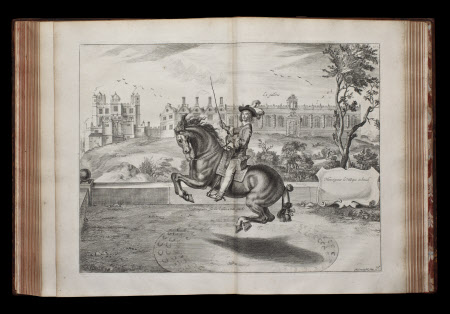Methode et invention nouvelle de dresser les chevaux / par le tres-noble, haut et tres-puissant Prince Guillaume Marquis et Comte de Newcastle Vicomte de Mansfield, Baron de Bolsover et Ogle; Seigneur de Cavendish, Bothel et Hepwel; pair D' Angleterre; Qui eut la charge et l'honneur d'estre Gouverneur du Serenissime Prince de Galles en sa jeunesse, maintenant Roy de la Grande Bretagne; Lieutenant pour le Roy de la Comté de Nottingham, & de la Forest de Sherwood; Capitaine general en toutes les provinces outre la Riviere de Trent, & autres endroits du Royaume d'Angleterre; Gentilhomme de la Chambre du Lit du Roy; Conseiller d'Etat et Privé; Chevalier du tres-noble Order de la Jarretiere, &c. Oeuvre auquel on apprend à travailler les chevaux selon la nature, & à parfaire la nature par la subtilité de l'art: traduit de l'Anglois de l' Auteur, par son Commandement; & enrichy de plus de quarante belles figures en taille douce.
William Cavendish, 1st Duke of Newcastle-upon-Tyne, KG, MP (1593-1676)
Category
Books
Date
1737
Materials
Place of origin
London
Order this imageCollection
Anglesey Abbey, Cambridgeshire
NT 3151012
Summary
William Cavendish, Marquess of Newcastle, Methode et Invention Nouvelle de Dresser les Chevaux, Antwerp: Jacques can Meurs, 1658. Binding: Gilt-tooled calfskin, c.1740, re-backed and repaired.
Full description
William Cavendish (1593-1676), successively Earl, Marquess, and finally Duke of Newcastle, was a grandson of Bess of Hardwick and was brought up at Welbeck Abbey in Nottinghamshire with his brother, the mathemetician Charles Cavendish. A patron of Ben Jonson and governor to the future Charles II, he became one of the leading Royalist commanders in the Civil War (1642–51). With the Royalist defeat at the Battle of Marston Moor in 1644, Newcastle fled to the Continent, and was condemned to death in absentia by the parliamentary authorities on 14 March 1649. He spent his exile in Antwerp, where he rented the magnificent town house and studio created between 1616 and 1640 by Peter Paul Rubens, from the artist’s widow. Back in England, one of Newcastle’s great passions had been horsemanship. In his youth, along with the short-lived Henry, Prince of Wales, he had been trained in the art of manège by the great French riding master M. de St. Antoine. He commissioned a magnificent riding school from the architect John Smythson at Welbeck, and another at Bolsover Castle in Derbyshire. Newcastle pursued his passion still further in Antwerp, according to some converting Rubens’s studio into yet another riding school and publishing this magnificent folio guide to equestrian pursuits in 1658. This extravagant project cost £1,300, beyond the pocket of an exiled marquess and had to be underwritten by friends. The text, originally written in English, was professionally translated into French to appeal to an international audience and the 33 splendid plates were engraved after designs by Abraham van Diepenbeeck (c.1596–1675), the son of an Antwerp glass painter who became one of Rubens’s most esteemed pupils. Despite his devout Catholicism and his connections with the Jesuits, Diepenbeeck was already well known to his English patron, and had designed frontispieces for several books published by Newcastle's wife Margaret, Marchioness (and eventually Duchess) of Newcastle. Text adapted from Mark Purcell's entry in 'Treasures from Lord Fairhaven's Library at Anglesey Abbey', 2013, cat. 5, pp. 51–3.
Bibliographic description
Seconde edition. iv, [8], 236p., double-page spread plates : ill., ports. ; fol. Provenance: Pencil inscription on flyleaf: From the Earl of Pembroke's Library. Twentieth-century armorial bookplate, signed G.S. 24 [i.e. 1924]: Urban Huttleston Rogers Broughton [i.e. Urban Huttleston Rogers Broughton, 1st Baron Fairhaven (1896-1966), of Anglesey Abbey]. Historic shelfmarks on front free endpaper: "Ii.8" [red ink] and "F" [pencil]. Binding: Eighteenth-century full mottled calf over boards; rebacked in calf preserving part of original gilt spine; red spine label with title 'Methode de dresser les chevaux'; sewn on six raised bands; gilt board edges; red textblock edges; marbled endpapers.
Provenance
‘From the Earl of Pembroke’s library’ – pencilled note. Acquired by Huttleston Rogers Broughton, 1st Lord Fairhaven (1896-1966) and then bequeathed by him to the National Trust with the house and the rest of the contents in 1966.
Makers and roles
William Cavendish, 1st Duke of Newcastle-upon-Tyne, KG, MP (1593-1676), author
